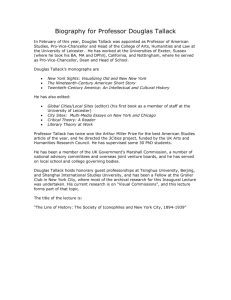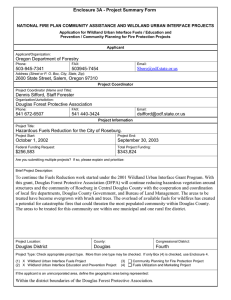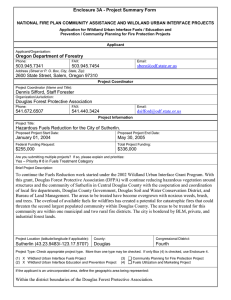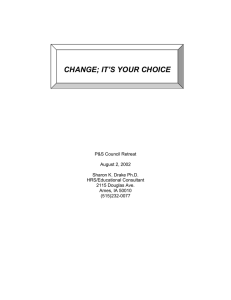Enclosure 3A - Project Summary Form
advertisement
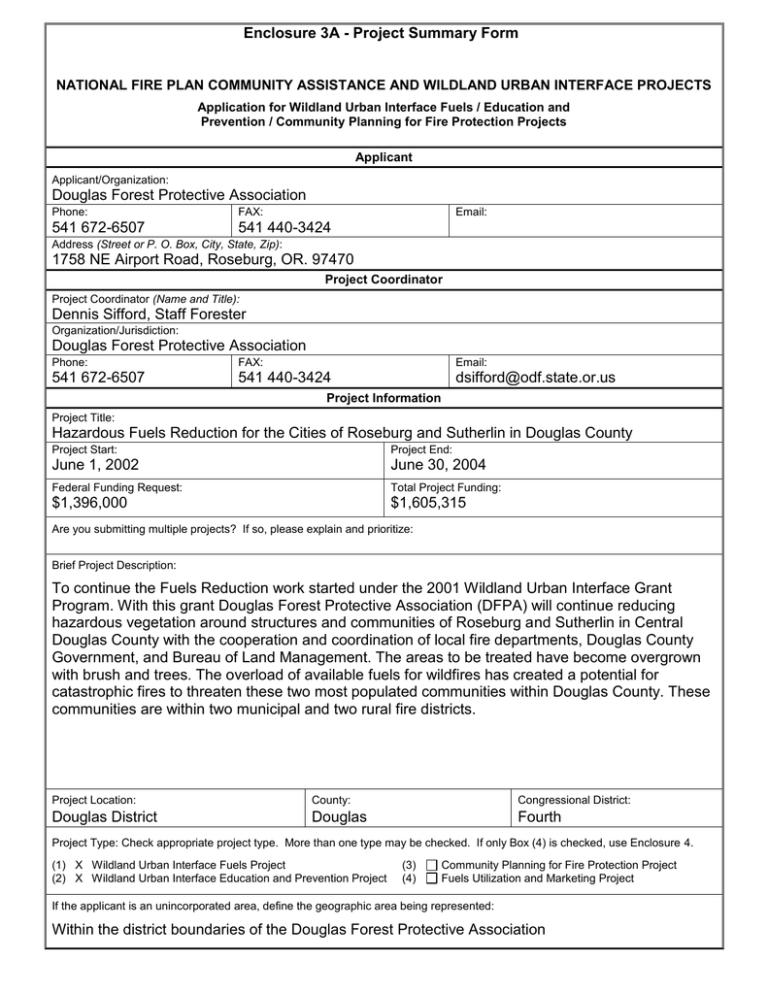
Enclosure 3A - Project Summary Form NATIONAL FIRE PLAN COMMUNITY ASSISTANCE AND WILDLAND URBAN INTERFACE PROJECTS Application for Wildland Urban Interface Fuels / Education and Prevention / Community Planning for Fire Protection Projects Applicant Applicant/Organization: Douglas Forest Protective Association Phone: FAX: 541 672-6507 541 440-3424 Email: Address (Street or P. O. Box, City, State, Zip): 1758 NE Airport Road, Roseburg, OR. 97470 Project Coordinator Project Coordinator (Name and Title): Dennis Sifford, Staff Forester Organization/Jurisdiction: Douglas Forest Protective Association Phone: FAX: Email: 541 672-6507 541 440-3424 dsifford@odf.state.or.us Project Information Project Title: Hazardous Fuels Reduction for the Cities of Roseburg and Sutherlin in Douglas County Project Start: Project End: June 1, 2002 June 30, 2004 Federal Funding Request: Total Project Funding: $1,396,000 $1,605,315 Are you submitting multiple projects? If so, please explain and prioritize: Brief Project Description: To continue the Fuels Reduction work started under the 2001 Wildland Urban Interface Grant Program. With this grant Douglas Forest Protective Association (DFPA) will continue reducing hazardous vegetation around structures and communities of Roseburg and Sutherlin in Central Douglas County with the cooperation and coordination of local fire departments, Douglas County Government, and Bureau of Land Management. The areas to be treated have become overgrown with brush and trees. The overload of available fuels for wildfires has created a potential for catastrophic fires to threaten these two most populated communities within Douglas County. These communities are within two municipal and two rural fire districts. Project Location: County: Congressional District: Douglas District Douglas Fourth Project Type: Check appropriate project type. More than one type may be checked. If only Box (4) is checked, use Enclosure 4. (1) X Wildland Urban Interface Fuels Project (2) X Wildland Urban Interface Education and Prevention Project (3) (4) Community Planning for Fire Protection Project Fuels Utilization and Marketing Project If the applicant is an unincorporated area, define the geographic area being represented: Within the district boundaries of the Douglas Forest Protective Association Enclosure 3B (Page 1 of 3) - Project Narrative Description Applications for funding must include a narrative response that describes the proposal. Please do not submit responses longer than one page, single space, 12-pitch font. Describe project including, but not limited to: project location Address these project implementation items as anticipated outcomes applicable: measures and reporting partners project income project time frames specify types of activities and equipment used amount or extent of actions (acres, number of homes, etc) environmental, cultural and historical resource requirements Response: Currently individual homeowners and community leaders have requested fuel reduction projects within these communities for the purposes of creating defensible space around structures, and/or creating fuel breaks adjacent to subdivisions and communities by reducing hazardous amounts of fuel buildup. There are approximately 49,000 residences within greater Douglas County that are located within municipalities and unincorporated areas. These communities are represented by 24 rural fire departments and 2 municipal fire departments. Hazardous amounts of fuel buildup exist on Bureau of Land Management (BLM), United States Forest Service (USFS), and adjacent private lands that surround or are adjacent to all Douglas County communities. This grant request is to continue the Hazardous Fuel Reduction work conducted under the 2001 Wildland Urban Interface Grant Program within Douglas County. Over 150 acres have been treated with an estimated 90 structures benefiting from the removal and maintenance of hazardous fuels. This projects funding will provide assistance to those who are physically or financially unable to do the work themselves. Douglas County’s unemployment rate is currently over 10%. A DFPA employee will be assigned to visit each specific site or area with the landowner(s) to evaluate the work needing to be done. This meeting will offer an opportunity to educate the landowners about a variety of fire prevention aspects around their homes. The project proposals will be presented for approval to the WUI grant review committee, which is appointed by the County Fire Chief from the members of the Douglas County Fire Chiefs Association. If the landowner does not do the work, then the DFPA employee will provide an onsite meeting with the work crew assigned to discuss the specifics of the project and monitor the progress of the work. DFPA will implement a pilot project with local fire crew contractors that will utilize their seasonal crews during the winter and spring months to provide fuel treatment work for this project. DFPA will also utilize their own seasonal workforce to provide a crew for fuel treatment work for this project during the winter and spring months. The goal is to treat 1000 to 1500 acres of the approximately 9900 acres identified within and around the cities of Roseburg and Sutherlin between June 2002 and June 2004. Fuels reduction work will include removing overgrown grasses and brush, ladder fuel reduction, pruning tree limbs, thinning overstocked stands, and debris disposal. This will be accomplished by hand and mechanized equipment. The removed material will be utilized for firewood, landscaping chips, hauled to a disposal site to be recycled as mulching material, or piled and burned. Enclosure 3B (Page 2 of 3) - Project Evaluation Criteria Applications for funding must include narrative responses that address the following four criteria. Within each criterion, subcriteria are listed in descending order of importance. Limit your responses to the areas provided. 1. Reducing Fire Risk. (40 points)) A. Describe how the proposal promotes reduction of risk in high hazard areas or communities. B. Describe how the proposed project benefits resources on federal land or adjacent non-federal land, or how it protects the safety of communities. C. To what extent does the project implement or create a cooperative fuels treatment plan or community fire strategy (include evidence of the plan if it already exists)? D. Explain to what extent the affected community or proponent has been involved or plans to involve the affected community in a qualified fuels education program (e.g., FIREWISE). E. Explain how the proposal (a) leads to, enhances or restores a local fire-adapted ecosystem, and/or (b) mitigates or leads to the mitigation of hazardous fuel conditions. F. How will the proposed treatments be maintained over time? Response: A. The reduction of hazardous fuels in and around structures of high hazard communities and areas promotes the likelihood of the structure and community surviving a wildfire threat, because it reduces the amount of available fuel to burn, and provides a safer environment for firefighters to deploy resources. B. BLM ownership is checker-boarded with private ownership throughout Douglas County. These lands are adjacent to and surround many of the high hazard area/communities identified on the National Registry. In addition, the eastern portion of Douglas County is managed by the USFS in which private lands are adjacent or intermixed within the national forest boundary. Reducing the fuels around these communities where the majority of people live reduces the risk of a wildfire spreading to or from these ownerships. C. Coordination and communication has been ongoing with the fire staffs of the local USFS, BLM, and local fire districts within the project areas. D. A Firewise Workshop is being conducted for Douglas County in March 2002 to educate community leaders and planners about the importance of planning for Firewise communities. E. This project will continue the efforts started in 2001 to reduce the hazardous fuel in and around Douglas County communities, mitigating the amount of available fuels and heavy fuel loadings that create more intense, explosive, and destructive fires during dry periods throughout the year. F. By reducing the overgrowth of vegetation and removing dead material that has accumulated over the past 50+ years, these projects will provide sites that can be managed by the homeowners on a routine basis. 2. Increasing local capacity. (30 points) A. How would the proposal improve or lead to the improvement of the local economy in terms of jobs and sustainable economic activity? How many jobs are expected to be created or retained and for how long (please distinguish between essentially yearround and seasonal jobs)? B. To what extent will this project be offered to serve as a model for other communities? C. Will biomass or forest fuels be utilized; if so, in what manner and how much? Response: A. This project will help provide employment during the 24 month period of June 2002 through June 2004, for local fire contract crews, and seasonal DFPA employees organized as a crew during the winter and spring months when these crews and individuals are normally unemployed. DFPA's project coordinator will be utilized to conduct the project evaluations and progress monitoring. B. Documented successes of this project and past projects are shared with communitities, community leaders, and other agencies through the local media, onsite tours, and meetings. C. Most of the material from the projects is utilized for firewood by the landowner, chipped for landscaping material or recycled as mulching or composting through the Douglas County Public Works Department. Enclosure 3B (Page 3 of 3) - Project Evaluation Criteria 3. Increasing interagency and intergovernmental coordination. (15 Points) A. Describe how this project implements a local intergovernmental strategy plan, or creates such a plan. Describe the plan if it already exists. B. Explain the level of cooperation, coordination or strategic planning among federal, state, tribal, local government and community organizations. List the cooperators. Response: A. There is not a current formal intergovernmental strategic plan to reduce hazardous fuels within or around high risk communities within Douglas County. However, the consensus among all the fire service agencies is that the current fuel loading has the potential to become a devastating fire situation, and any program that will reduce the amount of fuel will be beneficial for Douglas County. B. DFPA has worked closely with the Oregon Department of Forestry, US Forest Service, BLM, Douglas County, Forest Landowner Associations, Douglas County Fire Chiefs Association, Douglas County Fire Prevention Cooperative, local community leaders and associations, homeowner groups, and individuals on numerous projects. 4. Expanding Community Participation. (15 Points) A. To what extent have interested people and communities been provided an opportunity to become informed and involved in this proposal? B. Describe the extent of local support for the project, including any cost-sharing arrangements. C. What are the environmental, social and educational benefits of the project? Response: A. Outreach has been and will continue to be accomplished through local media (newspaper, radio, and television) coverage of the projects, community/townhall meetings, meetings with all our cooperators, informational signs, community events, association newsletters, and by word of mouth. We provide assistance to landowners interested in participating through completion of the application forms, and through arranging a workforce and equipment to complete the project work. B. Support for the project has been extraordinary from the County Commissioners to the next door neighbor. The local fire departments have agreed to provide time to inform and educate landowners within their jurisdictions of the importance of providing a fire safe community. C. This program will provide resources to develop a healthy fire-resistant ecosystem for all that utilize the treated areas, including wildlife. Landowners and community leaders will benefit from the educational aspects of the project meetings, and the actual accomplished work will demonstrate the importance of maintaining fuels within their communities. The areas treated will provide a more aesthetic and fire safe environment. The employment opportunities for local community members will provide social and economic benefits to Douglas County. Enclosure 3C - Project Work Form Tasks Evaluate project sites and educate project landowners. Time Frame Ongoing June 2002 – June 2004 Responsible Party DFPA Project Coordinator, and local fire department staff. Develop contract with local fire crew contractors. August – September 2002 Organize DFPA seasonal workforce crew September 2002 & September 2003 DFPA staff. Implement fuel treatment projects. October – December 2002, January – June 2003, October – December 2003, and January – June 2004 DFPA Project Coordinator Inform public of program through media, townhall meetings, door-todoor contacts, and coordination with cooperators through tours and project updates. Ongoing June 2002 – June 2004 DFPA Project Coordinator & Dennis Sifford. July - September 2004 DFPA Project Coordinator & Dennis Sifford. Write final project accomplishment report. Dennis Sifford, DFPA Project Coordinator, local fire department staff, and DFPA staff. Enclosure 3D - Project Budget Cost Category Description Federal Agency Personnel Estimated salary + OPE Estimated landowners time Subtotal Applicant RFD’s BLM $38,092 $11,093 $49,185 $40,950 $28,180 $40,950 $28,180 $118,315 $555 $1110 $370 $2,035 $555 $1110 $370 $2,035 $7,679 $75,000 $1,786 $7,679 $75,000 $1,786 $3000 $1,500 $3000 $1,500 Total Fringe Benefits Subtotal Travel Estimated vehicle mileage cost Subtotal Equipment Provided vehicles & equipment Subtotal $84,465 Supplies Subtotal Contractual 1500 acres @ $750/acre for crew labor and mileage estimate. Subtotal Other Administrative cost. ESA/NEPA surveys if needed. Subtotal Total Costs $4,500 $1,125,000 $1,125,000 $1,125,000 $171,000 $100,000 $271,000 $271,000 $1,396,000 $60,419 $118,560 $30,336 $1,605,315 Project (Program) Income1 1 Program income is the gross revenue generated by a grant or cooperative agreement supported activity during the life of the grant. Program income can be made by recipients from fees charged for conference or workshop attendance, from rental fees earned from renting out real property or equipment acquired with grant or cooperative agreement funds, or from the sale of commodities or items developed under the grant or cooperative agreement. The use of Program Income during the project period may require prior approval by the granting agency.

